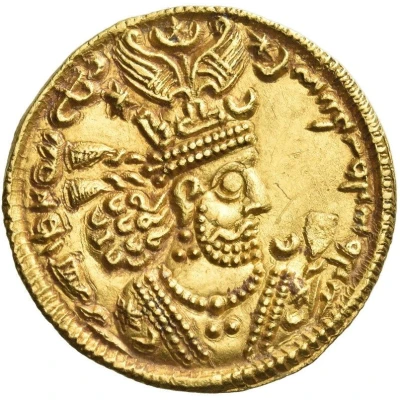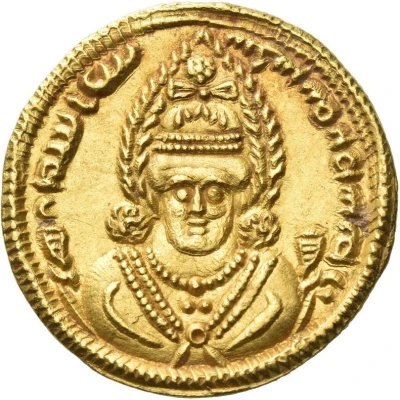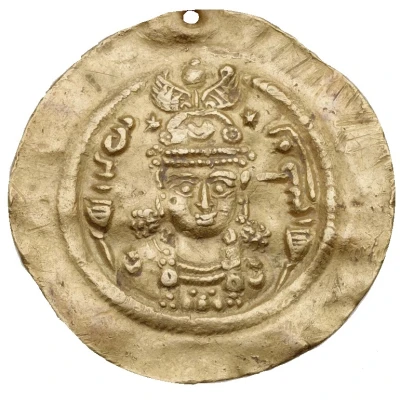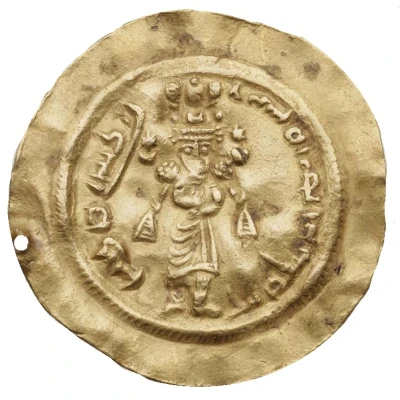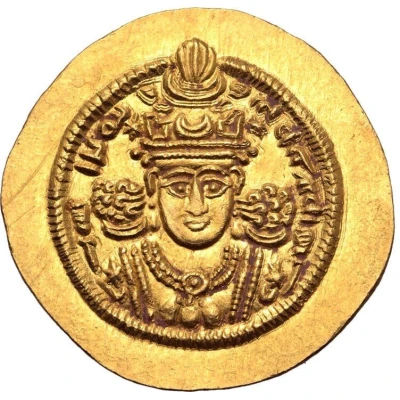


Dinar - Ardashir III
| Gold | 4.19 g | 24 mm |
| Issuer | Sasanian Empire (Sasanian Empire (224-651)) |
|---|---|
| Emperor | Ardashir III (628-630) |
| Type | Non-circulating coin |
| Years | 628-629 |
| Value | Dinar (1) |
| Currency | Dinar (224 AD-651 AD) |
| Composition | Gold |
| Weight | 4.19 g |
| Diameter | 24 mm |
| Shape | Round (irregular) |
| Technique | Hammered |
| Orientation | 9 o'clock ↑← |
| Demonetized | 0630 |
| Updated | 2024-10-10 |
| Numista | N#379127 |
|---|---|
| Rarity index | 97% |
Reverse
King standing facing wearing cap surmounted by crenelated mural crown with globe and crescent above pair of wings; to left and right stars of crescents and hair is parted in two korymboi above shoulders; ribbons fly upwards from shoulders and holding inverted sword with both hands to the ground line; Pahlavi legends around from right to left: gyhan ap[e] bym kartar (‘rid the world of fear’), artastr (Ardashir) ay[a]ky (year one).
Edge
Plain
Comment
Unpublished in the standard references.
The dinar of Ardashir III is among the rarest if not the rarest of all Sasanian gold dinars. Likely struck for the king’s coronation, it follows the standard special issues of Sasanian kings displaying the child king in a facing portrait on the obverse, and his standing figure holding his sword on the reverse. The obverse portrait shows Ardashir with the traditional crescent moon and star ornaments on either shoulder, and flowing ribbons behind. The reverse treatment is similar, with star and crescent over each shoulder, and ribbons to either side. This standing posture was first seen in a relief depicting Shapur I, but was immortalized by Shapur II in Taq-e Bostan showing the king and his successor Shapur III standing next to each other both adopting this royal pose. It is struck in the same fabric, die engraving style and employing the same dotted border as the dinar issue of Khusro II year 36 (AD 625/6). Interestingly, the coinage of Kavad II and Ardashir III both avoid using the traditional Sasanid title shahanshah (‘king of kings’) preferring apzwn (‘he has increased or augmented / ever increasing glory’), seemingly in order differentiate themselves from the reign Khusro II.
Facing portraiture had commenced on the Sasanian coinage with Ardashir I, and was employed on the gold coinage of Bahram IV, Valkash, Kavad I, Khosrau I, Khosrau II and Queen Buran, and all clearly represent extraordinary issues. This seems to be borne out by the circumstances of the known issues, with for example (per R. Gobl) the Khosrau II facing issue being minted at the height of the conflict with the Byzantine Empire.
Interesting fact
One interesting fact about the Non-circulating coin Dinar - Ardashir III (628-629) from Sasanian Empire (Sasanian Empire (224-651)) made of Gold weighing 4.19 g is that it features an image of the king, Ardashir III, on one side and a fire altar on the other. The fire altar was an important symbol in Zoroastrianism, the dominant religion of the Sasanian Empire at the time. This coin is a rare and valuable example of the empire's numismatic history and is highly sought after by collectors.
